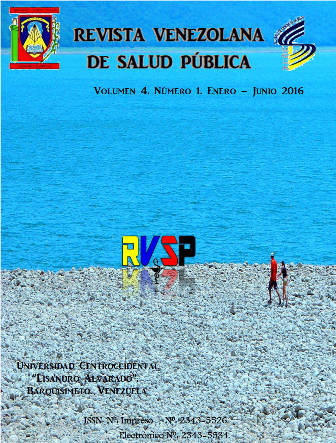Amoebic granulomatous encephalitis in an immunocompetent patient
Keywords:
Amoebic granulomatous encephalitis, immunocompetent patient, free-living amoebas.Abstract
Granulomatous amoebic encephalitis is an infrequent clinical entity, usually present in immunocompromised persons, where the few cases reported in the literature are due to infections by free-living amoebas present throughout the world, standing out as the most common agents, the Acanthamoeba sp. and Balamuthia mandrillaris. It is characterized by an insidious clinical course, that can be prolonged, but equally fatal. The clinic corresponds to that of intracerebral space occupying lesions, with seizures and focal deficits such as hemiparesis and cranial nerve lesions. Alterations of the sensorium, headache and neck stiffness are equally common, however, fever is usually sporadic and low grade. Occasionally there are pictures of pneumonitis, kidney or liver failure and sepsis.Downloads
References
119-28.
2. Oddó D, Ciani S, Vial P. Encefalitis amebiana granulomatosa por Balamuthia mandrillaris. Primer caso
diagnosticado en Chile. Rev Chil Infect. 2006;23(3): 232-236.
3. Castillo M, Gallegos J, Mendizábal R, Félix I, Rivas A. Absceso Cerebral multicentrico causado por Entamoeba histolytica. Arch Neurocien. 2004; 9(1):59-62.
4. Oddó D. Infecciones por amebas de vida libre. Comentarios históricos, taxonomía y nomenclatura, protozoología y cuadros anátomo-clínicos. Rev Chil Infect.2006;23(3):200-214
5. Astorga B. Amebas de vida libre: diagnóstico de Acanthamoeba sp. en pacientes con queratitis. Chile.
SOCHILTM. 2004;1-3
6. Petit F, Vilchez V, Torres G, Molina O, Dorfman S, Mora E, et al. Meningoencefalitis amebiana primaria:
Comunicacion de dos nuevos casos Venezolanos. Arq Neuropsiquiatr. 2006; 64(4):1043-46.
7. Peralta M, Ayala J. Amibas de vida libre en seres humanos. Salud Uninorte. 2009;25(2):280-292.
8. Torres C, Gotuzzo E. Enfermedades causadas por amebas de vida libre. Vitae: Academia Biomédica Digital
[Revista en Línea]. 2002[acceso 04 de abril de 2016]; 11[aprox 6 p.]. Disponible en:
http://caibco.ucv.ve/caibco/vitae/VitaeOnce/Articulos/Infectologia/Amebas/ArchivosHTML/Introducc.htm
9. Martínez A, Visvesvara G. Free-living, amphyzoicand opportunistic amoebas. Brain Pathol. 1997;7:583-98.
10. Fowler N, Carter RT. Acute pyogenic meningitis probably due to Acantamoeba sp: a preliminary report. Br Med
J. 1965;2:740-742.
11. Martinez J. Infection of the central nervous system due to acanthamoeba. Rev Inf Dis. 1991;13:399-402.
12. Martinez J. Free-living amebas: natural history, prevention, pathology, and treatment of disease. Boca Raton:
CRC Press. 1985:156.
13. Tavares W, Carneiro L. Infección por amebas de vida libre. En: Diagnóstico y tratamiento en Infectología y
Parasitología. México D.F.: Manual Moderno; 2009. p. 574-51.
14. Kidelen AF, Laube U. Balamuthia mandrillaris, anopportunistic agent of granulomatous amebic encephalitis,
infects the brain via the olfactory nerve pathway. Parasitol Res.2004;94: 49-52.
15. Gelman B B, Rauf S J, Nader R, Popov V,Borkowski J, Chaljub G, Nauta H W, Visvesvara GS. Amoebic
encephalitis due to Sappinia diploidea. JAMA 2001;16;285:2450-1.
16. Martinez JA. Infection of the Central NervousSystem Due to Acanthamoeba. Rev Infect Dis 1991; 13(Suppl
5): S399-402.
Published
How to Cite
Issue
Section
Derechos del/de autor/es a partir del año de publicación
Esta obra está bajo la licencia:
Creative Commons Reconocimiento-NoComercial-CompartirIgual 4.0 Internacional (CC BY-NC-SA 4.0)
Las opiniones expresadas por los autores no necesariamente reflejan la postura del editor de la publicación ni de la UCLA. Se autoriza la reproducción total o parcial de los textos aquí publicados, siempre y cuando se cite la fuente completa y la dirección electrónica de esta revista. Los autores(as) tienen el derecho de utilizar sus artículos para cualquier propósito siempre y cuando se realice sin fines de lucro. Los autores(as) pueden publicar en internet o cualquier otro medio la versión final aprobada de su trabajo, luego que esta ha sido publicada en esta revista.



